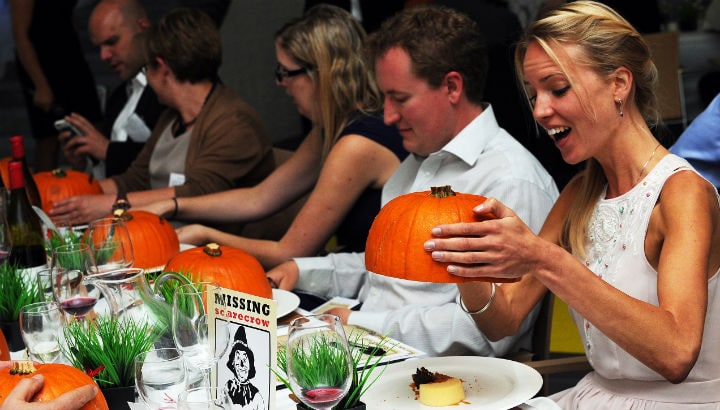
The world has changed a lot in the last 10 years, which has had a huge impact on business, culture and human behaviour. Old or safe thinking isn’t necessarily right for the society we currently live in.
In 2014 five key themes have emerged in marketing. These are; the value of storytelling, the availability of data and the insight it gives us, the role of neuroscience, what makes experiences shareable and the role of technology in our daily lives.
As a way of challenging my own thinking and building on these key themes, I was keen to do something a little different that would help inform future food marketing projects. I was absolutely delighted when Artizian Catering agreed to join forces as part of their Foodology concept.
The Foodology Event
For part one of the experiment, boutique caterer Artizian Catering showcased their unique Foodology concept to a packed room full of guests. This included leading food writers, consultants and guest of honour Antonio Carluccio. The seven course, fairy tale themed menu, devised by Artizian’s award-winning chef Richard Skinner, saw guests treated to a series of dishes each designed to provoke different emotions, including Hansel and Gretel’s Baked Bread Surprise, Goldilocks and The Three Bears Pea, Anchovy & Cured Ham Porridge and a Cinderella inspired Pumpkin Parfait.
For each course presented to them, guests were asked to rate and record their emotions both before and after tasting the dish.
It was well-received, Ian Hanlon, one of the guests and director at Coverpoint Foodservice Consultants said, “Like any good story, the food had an intriguing opening to get the ‘reader’ hooked, a strong main body and a sting in the tail at the end. Richard Skinner’s food was extremely well executed, each of the seven courses playing on a theme, which required all senses to piece together the story. A fun, interesting and interactive evening.”
The Online Survey
The data from the Foodology event was then collated and compared with an online study, where participants who had not been at the dinner recorded their emotions after viewing images of the dishes. To give a further comparison, two separate versions of the online survey were distributed; one displaying only the food images and one showing both the food images and a description of the dish.
Presenting the results
What the experiment found was that the more the user is involved in the story of a dish, the stronger their emotional reaction to it. With the ‘story’ often lost online, a neutral reaction is far more likely.
A scale of one to five measured the strength of participants’ emotions for both the offline tasting event and the online surveys. The results showed that people’s emotional reactions to the dishes were stronger offline, averaging a sore of 3.6. This fell to 2.7 for people viewing only the images online and interestingly, increased to 3.0 for people who view the images accompanied by a description of the dish. Adding descriptions to the online images also increased participants’ feelings of desire, disgust and surprise and made food appear more appetising than the images alone.
The scores suggest that the more consumers can know about and be part of a dish’s story, the stronger they feel towards it. This raises an important point for food marketers.
Ultimately, the research highlighted that there was no substitute for multi-sensory experience of eating food. While images of food receive high levels of engagement online and food with descriptions even more so, feelings and emotions were heightened across the spectrum when it came to actually eating the food. In fact, the study found that online people were more likely (29%) to have a neutral emotional reaction than in the real world, where the score was 11% for the same dish
Nathalie Nahai, a web psychologist, and her team played a key role in devising the experiment and analysing the findings.
“Although we all like to think that we’re rational,” she says, “research shows that when it comes to decision-making, our choices stem from emotional impulse – which means that every choice you make is influenced (and enabled) by the way you feel about it.
“Now, we all know that the brain is hard-wired to seek pleasurable experiences; but what you may not know is that the dopamine system (which makes us seek pleasure) is much stronger than the opioid system (which makes us feel it), meaning that in general, we seek more than we are satisfied.
“Food, like sex, is one of the primary ways in which we satiate our various appetites – and in our recent study we found that indeed, our real-world, offline experience of food and its rituals creates much stronger, more visceral and satisfying emotional responses.”
The panel session was just the start of deeper investigations into the relationship between digital media, food and human behaviour. We have further data to analyse and new insights to reveal, all of which are designed to offer valuable intelligence for the food, hospitality and marketing industries.
Karen Fewell, Digital Blonde
The panel
Chef Phil Howard – Two Stars Michelin Guide since 1998
Nathalie Nahai – Web Psychologist and author of ‘Webs of Influence: The Psychology of Online Persuasion’
Ed Butcher – Head of Online at Square Meal
Sam Michel – Director of Chinwag
Rob Kurz – Artizian’s Foodologist
Tracey Fairclough – Commercial Director, Artizian
If you are interested in knowing more or would like to get involved with further studies then email karen@digitalblondemarketing.com or tfairclough@artizian.co.uk
